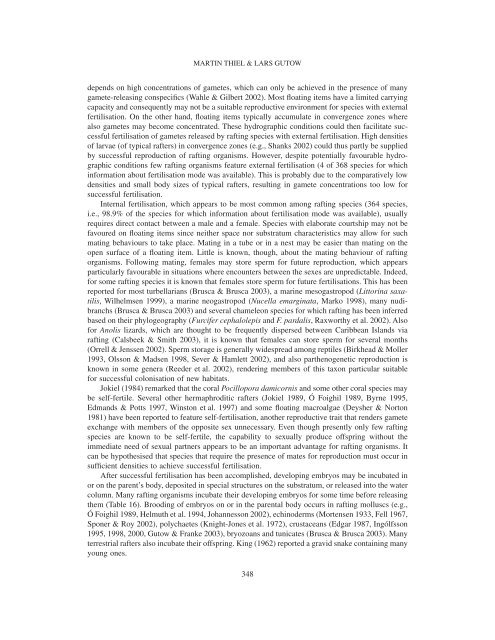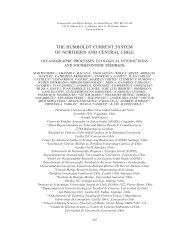The ecology of rafting in the marine environment - Bedim
The ecology of rafting in the marine environment - Bedim
The ecology of rafting in the marine environment - Bedim
You also want an ePaper? Increase the reach of your titles
YUMPU automatically turns print PDFs into web optimized ePapers that Google loves.
MARTIN THIEL & LARS GUTOW<br />
depends on high concentrations <strong>of</strong> gametes, which can only be achieved <strong>in</strong> <strong>the</strong> presence <strong>of</strong> many<br />
gamete-releas<strong>in</strong>g conspecifics (Wahle & Gilbert 2002). Most float<strong>in</strong>g items have a limited carry<strong>in</strong>g<br />
capacity and consequently may not be a suitable reproductive <strong>environment</strong> for species with external<br />
fertilisation. On <strong>the</strong> o<strong>the</strong>r hand, float<strong>in</strong>g items typically accumulate <strong>in</strong> convergence zones where<br />
also gametes may become concentrated. <strong>The</strong>se hydrographic conditions could <strong>the</strong>n facilitate successful<br />
fertilisation <strong>of</strong> gametes released by <strong>raft<strong>in</strong>g</strong> species with external fertilisation. High densities<br />
<strong>of</strong> larvae (<strong>of</strong> typical rafters) <strong>in</strong> convergence zones (e.g., Shanks 2002) could thus partly be supplied<br />
by successful reproduction <strong>of</strong> <strong>raft<strong>in</strong>g</strong> organisms. However, despite potentially favourable hydrographic<br />
conditions few <strong>raft<strong>in</strong>g</strong> organisms feature external fertilisation (4 <strong>of</strong> 368 species for which<br />
<strong>in</strong>formation about fertilisation mode was available). This is probably due to <strong>the</strong> comparatively low<br />
densities and small body sizes <strong>of</strong> typical rafters, result<strong>in</strong>g <strong>in</strong> gamete concentrations too low for<br />
successful fertilisation.<br />
Internal fertilisation, which appears to be most common among <strong>raft<strong>in</strong>g</strong> species (364 species,<br />
i.e., 98.9% <strong>of</strong> <strong>the</strong> species for which <strong>in</strong>formation about fertilisation mode was available), usually<br />
requires direct contact between a male and a female. Species with elaborate courtship may not be<br />
favoured on float<strong>in</strong>g items s<strong>in</strong>ce nei<strong>the</strong>r space nor substratum characteristics may allow for such<br />
mat<strong>in</strong>g behaviours to take place. Mat<strong>in</strong>g <strong>in</strong> a tube or <strong>in</strong> a nest may be easier than mat<strong>in</strong>g on <strong>the</strong><br />
open surface <strong>of</strong> a float<strong>in</strong>g item. Little is known, though, about <strong>the</strong> mat<strong>in</strong>g behaviour <strong>of</strong> <strong>raft<strong>in</strong>g</strong><br />
organisms. Follow<strong>in</strong>g mat<strong>in</strong>g, females may store sperm for future reproduction, which appears<br />
particularly favourable <strong>in</strong> situations where encounters between <strong>the</strong> sexes are unpredictable. Indeed,<br />
for some <strong>raft<strong>in</strong>g</strong> species it is known that females store sperm for future fertilisations. This has been<br />
reported for most turbellarians (Brusca & Brusca 2003), a mar<strong>in</strong>e mesogastropod (Littor<strong>in</strong>a saxatilis,<br />
Wilhelmsen 1999), a mar<strong>in</strong>e neogastropod (Nucella emarg<strong>in</strong>ata, Marko 1998), many nudibranchs<br />
(Brusca & Brusca 2003) and several chameleon species for which <strong>raft<strong>in</strong>g</strong> has been <strong>in</strong>ferred<br />
based on <strong>the</strong>ir phylogeography (Furcifer cephalolepis and F. pardalis, Raxworthy et al. 2002). Also<br />
for Anolis lizards, which are thought to be frequently dispersed between Caribbean Islands via<br />
<strong>raft<strong>in</strong>g</strong> (Calsbeek & Smith 2003), it is known that females can store sperm for several months<br />
(Orrell & Jenssen 2002). Sperm storage is generally widespread among reptiles (Birkhead & Moller<br />
1993, Olsson & Madsen 1998, Sever & Hamlett 2002), and also par<strong>the</strong>nogenetic reproduction is<br />
known <strong>in</strong> some genera (Reeder et al. 2002), render<strong>in</strong>g members <strong>of</strong> this taxon particular suitable<br />
for successful colonisation <strong>of</strong> new habitats.<br />
Jokiel (1984) remarked that <strong>the</strong> coral Pocillopora damicornis and some o<strong>the</strong>r coral species may<br />
be self-fertile. Several o<strong>the</strong>r hermaphroditic rafters (Jokiel 1989, Ó Foighil 1989, Byrne 1995,<br />
Edmands & Potts 1997, W<strong>in</strong>ston et al. 1997) and some float<strong>in</strong>g macroalgae (Deysher & Norton<br />
1981) have been reported to feature self-fertilisation, ano<strong>the</strong>r reproductive trait that renders gamete<br />
exchange with members <strong>of</strong> <strong>the</strong> opposite sex unnecessary. Even though presently only few <strong>raft<strong>in</strong>g</strong><br />
species are known to be self-fertile, <strong>the</strong> capability to sexually produce <strong>of</strong>fspr<strong>in</strong>g without <strong>the</strong><br />
immediate need <strong>of</strong> sexual partners appears to be an important advantage for <strong>raft<strong>in</strong>g</strong> organisms. It<br />
can be hypo<strong>the</strong>sised that species that require <strong>the</strong> presence <strong>of</strong> mates for reproduction must occur <strong>in</strong><br />
sufficient densities to achieve successful fertilisation.<br />
After successful fertilisation has been accomplished, develop<strong>in</strong>g embryos may be <strong>in</strong>cubated <strong>in</strong><br />
or on <strong>the</strong> parent’s body, deposited <strong>in</strong> special structures on <strong>the</strong> substratum, or released <strong>in</strong>to <strong>the</strong> water<br />
column. Many <strong>raft<strong>in</strong>g</strong> organisms <strong>in</strong>cubate <strong>the</strong>ir develop<strong>in</strong>g embryos for some time before releas<strong>in</strong>g<br />
<strong>the</strong>m (Table 16). Brood<strong>in</strong>g <strong>of</strong> embryos on or <strong>in</strong> <strong>the</strong> parental body occurs <strong>in</strong> <strong>raft<strong>in</strong>g</strong> molluscs (e.g.,<br />
Ó Foighil 1989, Helmuth et al. 1994, Johannesson 2002), ech<strong>in</strong>oderms (Mortensen 1933, Fell 1967,<br />
Sponer & Roy 2002), polychaetes (Knight-Jones et al. 1972), crustaceans (Edgar 1987, Ingólfsson<br />
1995, 1998, 2000, Gutow & Franke 2003), bryozoans and tunicates (Brusca & Brusca 2003). Many<br />
terrestrial rafters also <strong>in</strong>cubate <strong>the</strong>ir <strong>of</strong>fspr<strong>in</strong>g. K<strong>in</strong>g (1962) reported a gravid snake conta<strong>in</strong><strong>in</strong>g many<br />
young ones.<br />
348










